Exploring the Unique Appeal of Walk-In Bird Aviaries
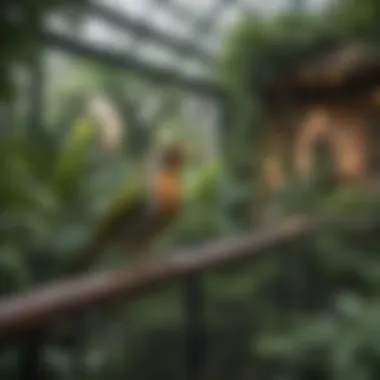
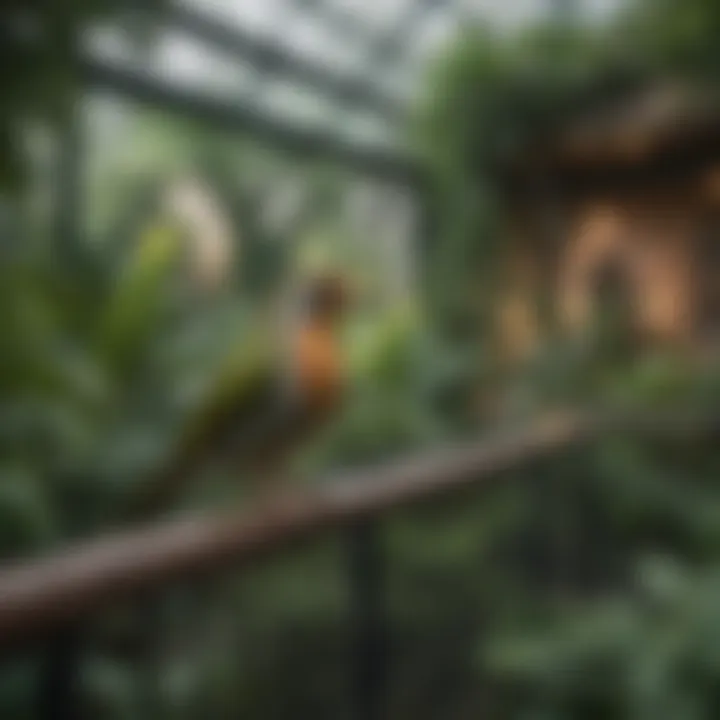
Intro
Walk-in bird aviaries are more than just structures for housing birds; they represent a meaningful environment that enhances the quality of life for avian companions. The concept of these spacious enclosures transcends conventional caged bird keeping. They allow for natural behaviors, fostering physical and emotional well-being in pet birds. This article explores various aspects of walk-in aviaries, including construction, care, and the unique experiences they provide not only for the birds but also for their owners. By delving into the essentials of establishing and maintaining an aviary, we aim to equip bird enthusiasts with the knowledge necessary to create an enriching habitat.
Care Tips
Creating a successful walk-in bird aviary involves understanding the daily care routines, setup, maintenance, hygiene, and adjustments needed to ensure a healthy and happy environment. Here are essential components every bird owner should consider:
Daily Care Routines
Birds require consistent care. Daily routines should include feeding, monitoring their behavior, and ensuring clean water is always available. Observing any changes in activity or appetite can help identify potential health issues early.
Cage Setup and Maintenance
Aviary setup is crucial. Select a suitable location that provides natural light and protection from harsh weather. The aviary should be spacious, with perches, plants, and toys for stimulation. Regular maintenance ensures that it remains a safe habitat. Check for any damages or hazards frequently.
Hygiene and Cleaning Practices
Hygiene is key to a healthy aviary. Efforts should be made to keep the aviary clean by removing waste, replacing bedding, and sanitizing food and water containers regularly. Use bird-safe cleaning agents to ensure the safety of your feathered friends.
Seasonal Care Adjustments
Different seasons bring various considerations. In winter, keep the aviary warm and ensure birds have adequate shelter. In summer, provide shade and fresh water while monitoring for overheating. Adapting care based on the seasons supports the well-being of your birds.
"A well-maintained walk-in aviary enhances both avian well-being and owner satisfaction, creating a symbiotic relationship."
Behavioral Insights
Understanding bird behavior and the nuances of avian communication is essential for effective interaction with your birds. Here are some insights:
Understanding Bird Body Language
Birds communicate through body language. Signs of contentment include relaxed posture and chirping. Conversely, puffed feathers or aggressive displays may indicate stress or discomfort.
Common Behavioral Issues and Solutions
Issues like feather plucking and aggression are common but manageable. Identifying stressors and improving the environment can help mitigate these behaviors. Consider consulting an avian veterinarian for persistent issues.
Positive Reinforcement Techniques
Training birds can foster better behavior. Positive reinforcement through treats or affection encourages desired actions without stress. Consistent and gradual training builds trust and strengthens the bond.
Social Interaction Needs
Birds are social creatures. Encourage interaction, whether engaging with humans or other birds. A lack of socialization can lead to loneliness and behavioral issues.
Nutrition Guides
Proper nutrition is a cornerstone of your birds' health. Here’s what to keep in mind:
Essential Diet Components
A balanced diet should include seeds, pellets, fresh fruits, and vegetables. Each species may have different nutritional needs, so research is vital to ensure a complete diet.
Safe and Toxic Foods
Knowledge of food safety is essential. For example, avocado and chocolate are toxic to birds. Familiarizing yourself with safe and harmful foods can prevent serious health issues.
Supplements and Treats
High-quality supplements provide additional nutrients. Offering occasional treats like millet or special seed blends can also enrich your birds’ diet.
Feeding Strategies for Different Species
Different bird species have unique dietary needs. Research species-specific requirements to avoid inadequacies in their diet. For instance, parrots require higher fat content than finches.
Wellness and Health
Regular health monitoring is essential for maintaining your birds' well-being. Consider the following:
Routine Health Checkups
Regular vet visits help in early disease detection. Schedule annual checkups to monitor overall health and receive vaccinations when necessary.
Identifying Symptoms of Illness
Awareness of symptoms such as lethargy, changes in droppings, or lack of appetite is crucial. Early identification leads to timely treatment.
Preventative Care and Vaccinations
Preventative care includes vaccinations and wellness checks. Staying informed about common avian diseases ensures your birds remain healthy.
Mental and Emotional Well-being
Mental health is as vital as physical health. Provide toys, interaction, and stimulation to promote emotional well-being. Spaces for exploration and safe environments contribute significantly to their happiness.
Enriching Activities
Engaging birds in various activities promotes physical and mental stimulation. Here are some suggestions for enriching their lives:
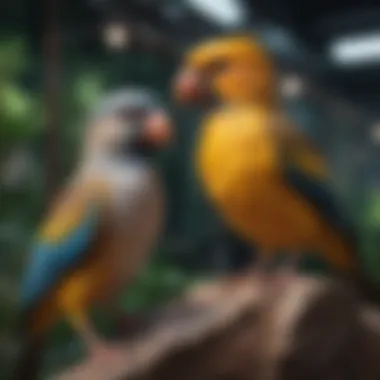
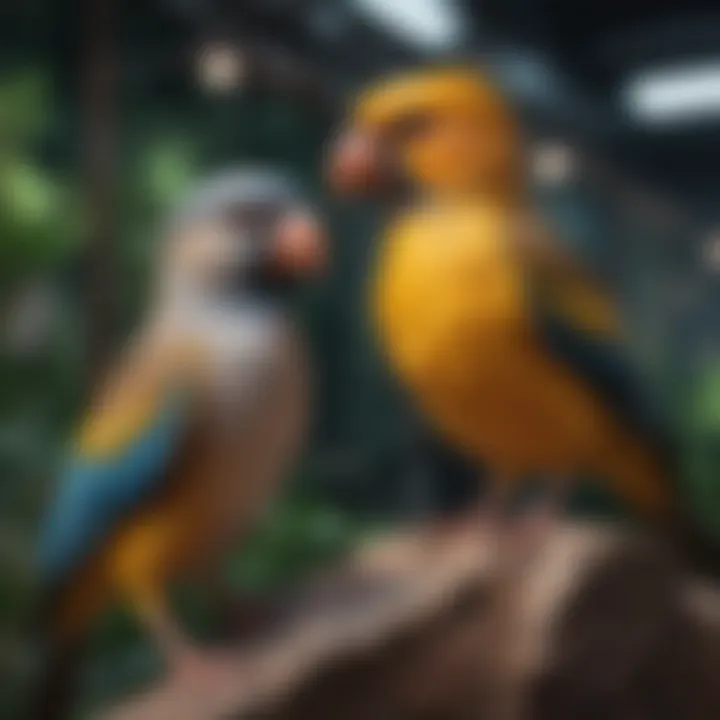
Toys and Playtime Ideas
Rotate toys regularly to keep interest high. Simple toys made from natural materials can provide entertainment while promoting natural behaviors.
Training and Tricks
Teach birds simple commands or tricks. This not only provides mental challenges but strengthens the bond between birds and owners.
Outdoor Activities and Interaction
Supervised outdoor time can offer birds new stimuli and fresh air. Always ensure safety by using harnesses or secure aviaries.
DIY Projects for Mental Stimulation
Consider creating your own toys or puzzles. Using everyday materials allows for hands-on activities and can be cost-effective.
By adapting these practices into their care routine, bird owners can ensure their avian companions thrive in a walk-in aviary setting.
Preamble to Walk-In Bird Aviaries
Walk-in bird aviaries serve as a unique fusion of habitat and interaction space for birds and their owners. These structures, designed to allow people to enter and interact with avian inhabitants, can transform the bird-keeping experience into something enriching and dynamic. As birds require a specific environment to thrive, the construction and utilization of walk-in aviaries encourage not only the welfare of the birds but also deepen the bond between birds and their human companions.
Definition and Overview
A walk-in bird aviary is essentially a large outdoor or indoor enclosure that allows birds to fly freely while being observed and interacted with by humans. Generally, these aviaries are designed with spaciousness in mind, enabling birds to exhibit natural behaviors, such as flying and socializing. The size varies greatly; some are as simple as small backyard structures, while others are elaborate setups requiring careful planning and design.
Through providing a naturalistic environment, the aviary must incorporate essential elements such as perches, plants, and appropriate flooring that stimulates the birds' instinctual needs. This creates a comfortable and secure environment for the birds to thrive.
Popularity Among Avian Enthusiasts
The popularity of walk-in bird aviaries has skyrocketed among avian enthusiasts due to several factors. First, they allow for an immersive experience that smaller cages do not provide. Bird owners can engage more closely with their pets, observing their behaviors and interactions in a natural setting. This engagement is crucial for both physical and mental health of birds.
Moreover, walk-in aviaries also facilitate social interactions among different species. The space encourages the formation of natural social groups, which can lead to healthier, more socially stimulated birds. This appeal extends beyond just amateur bird lovers to include breeders and professional caretakers seeking optimal living conditions for their birds.
In summary, the concept of walk-in bird aviaries draws its strength from their capacity to enhance avian life and provide a rich experience for bird owners. As awareness regarding avian welfare increases, the importance of these structures in bird care continues to grow.
Benefits of Walk-In Bird Aviaries
Walk-in bird aviaries offer several notable advantages that are worth considering for pet bird owners and enthusiasts. This section outlines the many benefits these structures provide, focusing on how they contribute positively to the lives of birds. The elements discussed here reveal the thoughtful considerations that enhance the well-being of avian companions as well as the experience of their owners.
Enhanced Living Space for Birds
Walk-in bird aviaries create a vast space for birds to move freely. Unlike traditional cages, which typically limit flight and exploration, an aviary offers a more natural environment. Birds can stretch their wings, fly at various heights, and engage in natural behaviors, which is essential for their physical health. The larger area encourages active lifestyles, which can lead to increased vitality.
Furthermore, having different zones within the aviary can satisfy a bird’s need for privacy and social interaction. This can include perches, feeding areas, and spots for bathing. The diversity in layout encourages exploration and can immensely enrich a bird's life.
Promoting Physical and Mental Health
The physical and mental health of birds is significantly enhanced by walk-in aviaries. These environments allow birds to partake in exercise, an essential component of their well-being. The ability to fly, climb, and explore reduces the risk of obesity and related health issues.
Moreover, interaction with various stimuli—such as different objects and the presence of other birds—can help stimulate a bird’s mind. Mental stimulation helps prevent issues like boredom and stress, both of which can lead to negative behaviors such as feather plucking. Engaging environments, coupled with ample physical space, lead to a happier, healthier bird.
"Providing birds with a larger space encourages natural behaviors, which is vital for their psychological well-being."
Facilitating Social Interactions
Walk-in aviaries support social dynamics among birds. They are designed to accommodate multiple species or individuals, allowing them to engage in social behaviors typical of their kind. Birds are inherently social creatures, and interaction with peers fosters companionship and can decrease feelings of loneliness.
This social setting provides opportunities for bonding and enrichment as birds interact with each other. They learn from each other and can exhibit playful behaviors that contribute to their happiness. Additionally, allowing pet owners to be part of this social environment enhances the connection between humans and birds, creating a fulfilling relationship that benefits all involved.
Designing a Walk-In Aviary
Designing a walk-in aviary requires careful planning and consideration. The structure itself not only defines the physical environment for the birds but also significantly influences their well-being and overall happiness. A well-designed aviary protects birds from predators, elements, and provides them enough space to explore, fly, and exhibit their natural behaviors. Therefore, approaching the design with meticulous thought is essential.
Location Considerations
The placement of the aviary is crucial. Choose a location that receives ample natural light while providing some shaded areas. Birds benefit from sunlight for vitamin D synthesis, but too much exposure can lead to overheating. Additionally, consider the view from your home. An aviary positioned in a visible area encourages regular interaction and makes for easy monitoring.
Nearby trees or large shrubs can provide natural protection against extreme weather conditions. However, avoid placing the aviary too close to busy areas that may cause stress for the birds. Noise from traffic or crowds can disrupt their peace. Instead, aim for a calm and serene environment to promote comfort and reduce agitation.
Size and Structure Requirements
The dimensions of the aviary must accommodate the species of birds you intend to house. Smaller birds like finches may need less space compared to larger species like macaws or cockatoos. A common recommendation is to provide at least 10 square feet of space for smaller birds, while larger birds may require significantly more—sometimes upwards of 50 square feet. Additionally, vertical space is important as birds enjoy flying upwards. Incorporate height in the aviary design to allow for ample flight room.
When constructing the structure, ensure it is sturdy and secure. The frame should be made of durable materials that withstand weather and environmental changes. The flooring must also be easy to clean and can include dirt, gravel, or tiles. It is essential to include multiple entry points for easy access during cleaning and maintenance.
Materials and Safety Standards
Selecting appropriate materials is vital for ensuring the safety of your birds. Use non-toxic paints and coatings, as birds are sensitive to fumes. Wire mesh is common for enclosures, but ensure it is of suitable gauge to prevent escapes or predator access. Stainless steel or coated wire is preferred due to its durability and corrosion resistance.
Regular inspection of the aviary’s structure should be scheduled. Check for any weaknesses in the materials or signs of wear and tear. The primary focus should always be on the safety and comfort of the birds. Ensuring the aviary meets local regulations regarding bird enclosures is essential as well.
Important Note: Always prioritize the health and safety of the birds over aesthetic preferences when designing an aviary.
Ultimately, designing a walk-in aviary is a blend of creativity and practicality. By addressing location, size, and materials, one can create a nurturing environment for birds that enhances their quality of life.
Interior Design and Enrichment
Understanding the significant role of interior design and enrichment in walk-in bird aviaries is essential for the well-being of the birds. The design elements are not just about aesthetics; they provide a necessary environment that caters to the physical, mental, and emotional needs of birds. Caregivers must prioritize certain features that promote natural behaviors and enhance the living experience for their avian inhabitants.
Natural Elements and Plant Life
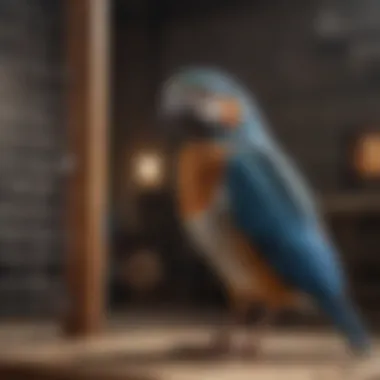
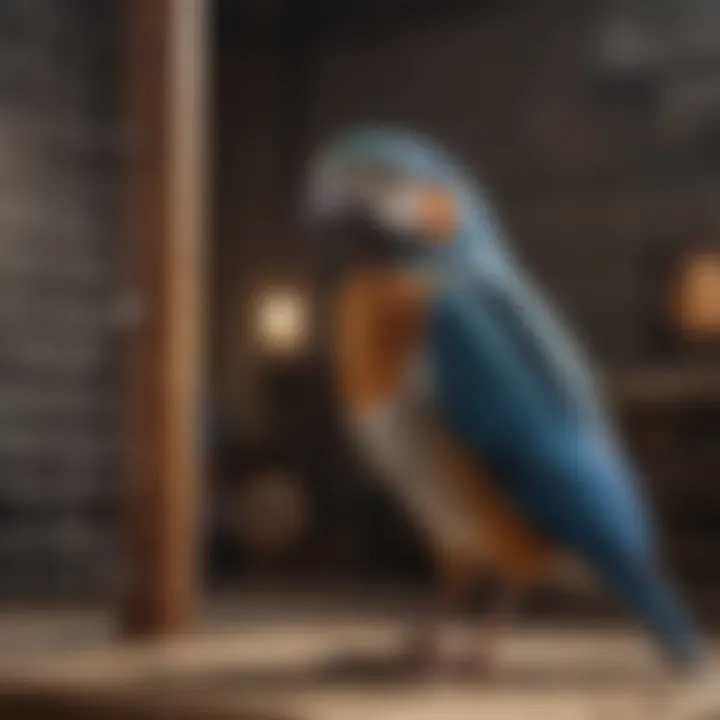
Incorporating natural elements into the aviary design is crucial. Plants play a vital role in mimicking birds' natural habitats. These living things provide shelter, reduce stress, and enhance airflow. Additionally, appropriate plant selection can contribute to a more stimulating environment. Non-toxic, bird-friendly plants such as spider plants, bamboo, and pothos are excellent choices. Care should be taken to choose species that thrive in the aviary's conditions. This includes considerations of humidity, lighting, and space available to the plants. In addition to creating a more attractive space, these elements can also encourage exploration and foraging behaviors, thereby improving the birds' overall health and happiness.
Perches and Climbing Structures
Perches are vital in an aviary, serving as a foundation for birds' daily activities. Different types of natural wood perches, paired with synthetic options, offer variety and comfort. Size, shape, and texture should vary to simulate the different surfaces that birds would encounter in the wild. This approach can prevent foot problems and promote overall well-being. Climbing structures such as ropes, ladders, and branches should be considered as well. They provide opportunities for exercise and social interactions among birds. Safeguards must always be in place to ensure these structures are secure and appropriate for the size and species of the birds housed within the aviary.
Toys and Activities for Birds
Mental stimulation is equally important for birds in an aviary. Toys are essential for preventing boredom and fostering natural behaviors. A variety of toys, including foraging toys, noise-making toys, and interactive puzzles, should be available. It is advisable to rotate toys regularly to maintain the birds' interest and engagement. Enrichment activities can also involve simple things like changing the aviary layout occasionally, thereby encouraging birds to explore and interact with their surroundings. Engaging birds actively connects them with their environment and reduces potential behavioral issues associated with confinement.
"Enrichment is not optional; it is a critical component of a bird's life in captivity."
Thus, creating an interior design filled with diverse elements and engaging activities can enhance the life quality of birds significantly. Each aspect, from natural plants to climbing opportunities and stimulating toys, contributes to a holistic environment that meets the needs of companion birds.
Maintenance and Care
Maintaining a walk-in bird aviary is essential for ensuring the well-being of the avian inhabitants and promoting a stable environment. This task involves routine cleaning, seasonal checks, and monitoring health aspects of the birds. Proper maintenance not only preserves the physical structure of the aviary but also enhances the quality of life for the birds, making it an integral part of bird ownership.
Daily Cleaning Routines
Daily cleaning is vital to prevent the buildup of waste and bacteria. A clean aviary promotes a healthy habitat for the birds. Here are some basic steps to include in the daily routine:
- Remove droppings: Fresh droppings should be removed daily to prevent health risks.
- Clean food and water dishes: These should be washed and sanitized every day to avoid contamination.
- Check perches and surfaces: Wipe down surfaces to eliminate residue and keep them hygienic.
- Inspect for any hazards: Look for frayed or damaged items that could potentially harm the birds.
By establishing a consistent daily cleaning routine, owners can help maintain a pleasant living space and minimize the risk of illness among the birds.
Seasonal Maintenance Checks
Every changing season brings different challenges that need to be addressed. Seasonal maintenance checks should be thorough and encompass various aspects:
- Inspect the structure: Check for any wear and tear in the aviary's framework, ensuring doors close properly and the mesh is intact.
- Evaluate the heating or cooling systems: If the aviary is climate-controlled, make sure systems are functioning efficiently for temperature regulation.
- Refresh substrates and plants: Change out bedding materials and assess the health of plants regularly, as some may need replacement.
- Conduct deep cleaning: Once a season, perform a more rigorous cleaning, including disinfecting surfaces and furnishings.
Seasonal checks allow the owner to proactively address potential issues before they become significant problems, creating a safer environment for the birds.
Health Monitoring and Veterinary Care
Regular health monitoring is crucial for the longevity of the birds. Bird owners should develop a habit of observing behavioral changes, appetite, and physical condition. Key points to focus on include:
- Daily health assessments: Check for signs of illness such as lethargy, ruffled feathers, or unusual droppings.
- Veterinary checkups: Schedule annual vet visits for comprehensive health assessments and vaccinations.
- Quarantine new birds: Integrate any new bird slowly to the existing flock, monitoring for any signs of disease before full integration.
Establishing a health routine supports the overall well-being of the flock and ensures any health issues are caught early, allowing for prompt action.
"Regular maintenance and vigilance can prevent many potential problems associated with avian care."
In summary, maintaining a walk-in bird aviary involves a series of routine and seasonal tasks. These tasks contribute not only to the aesthetic appeal of the environment but, more importantly, to the health and happiness of the birds within.
Choosing the Right Birds for Your Aviary
The selection of appropriate birds for your walk-in aviary is a vital aspect that can influence not only the well-being of your feathered companions but also the overall harmony in the aviary environment. Choosing the right species ensures that the birds can thrive while providing a fulfilling experience for both the birds and their owners. Considerations such as compatibility among species, size and space needs, as well as behavioral characteristics should guide your selection process.
Compatibility Among Species
When planning your aviary, understanding the compatibility between different bird species is crucial. Not all birds share the same temperament. Some are more territorial, while others are social and friendly. For example, smaller birds like finches often live well together in groups, whereas larger birds such as cockatoos may require more space and could be aggressive toward one another.
Before introducing new birds, it is essential to research their natural behaviors and social structures. The following points can help:
- Social Behavior: Identify whether a species is generally gregarious or solitary.
- Aggression Levels: Look into common aggressiveness within the species.
- Territorial Nature: Some birds defend their space aggressively.
Choosing species that can coexist peacefully is key to a healthy aviary environment.
Size and Space Considerations
The size of your aviary plays a significant role in determining what kinds of birds to keep. Birds require adequate space to move freely, climb, and fly. Larger birds usually need bigger spaces than small ones. Ignoring size requirements can lead to stress and health issues in birds, affecting their physical and mental well-being.
Here are some important size-related considerations:
- Minimum Space Requirements: Research the specific needs of each species concerning the size of the aviary.
- Flight Area: Ensure there is enough room for birds to fly without barriers.
- Vertical Space: Birds often utilize vertical space for climbing, so consider tall structures in your design.
Behavioral Traits and Dynamics
Behavioral traits of birds can vary widely and can significantly impact their interactions. Understanding these traits helps in choosing compatible species and ensuring their needs are met.
- Activity Level: Some birds are more active and require room for exercise.
- Socialization Needs: Certain breeds need more interaction, while others prefer solitude.
- Noise Levels: Some species are naturally loud. Make sure that your environment can accommodate them.
Legal and Ethical Considerations
The topic of legal and ethical considerations plays a crucial role in the realm of walk-in bird aviaries. Many bird owners may not fully understand the responsibilities that come with avian care. It is essential to ensure that all aspects of bird ownership comply with local laws and regulations. This not only protects the birds but also fosters a culture of responsible ownership among enthusiasts.
Regulations on Bird Ownership
Regulations regarding bird ownership vary across different regions. These laws may determine what species can be legally owned, the requirements for their care, and restrictions related to breeding. It is important for bird owners to familiarize themselves with these laws to avoid legal repercussions. Some cities or countries may prohibit the ownership of certain exotic birds. Failure to comply can lead to serious consequences, including fines or the removal of your birds.
Bird owners should also consider permits required for keeping certain species, especially those that are endangered or protected. Checking with local wildlife agencies can provide clarity on necessary licenses.
Welfare Standards for Avian Care
Welfare standards are essential to ensure that the health and well-being of birds are prioritized. These standards cover various aspects of care, including housing, nutrition, and socialization. Walk-in aviaries can significantly contribute to fulfilling these standards by providing ample space and stimulating environments for birds.
It is vital to provide appropriate dietary needs for each species, as improper nutrition can lead to health issues. Moreover, socialization is essential for birds, and aviaries enable interaction with other birds, promoting natural behaviors.
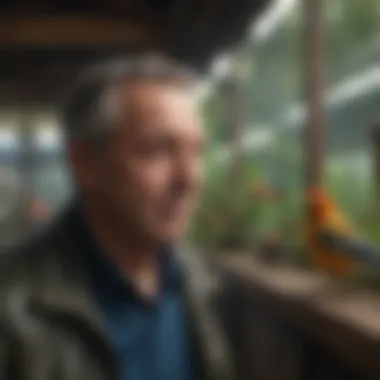
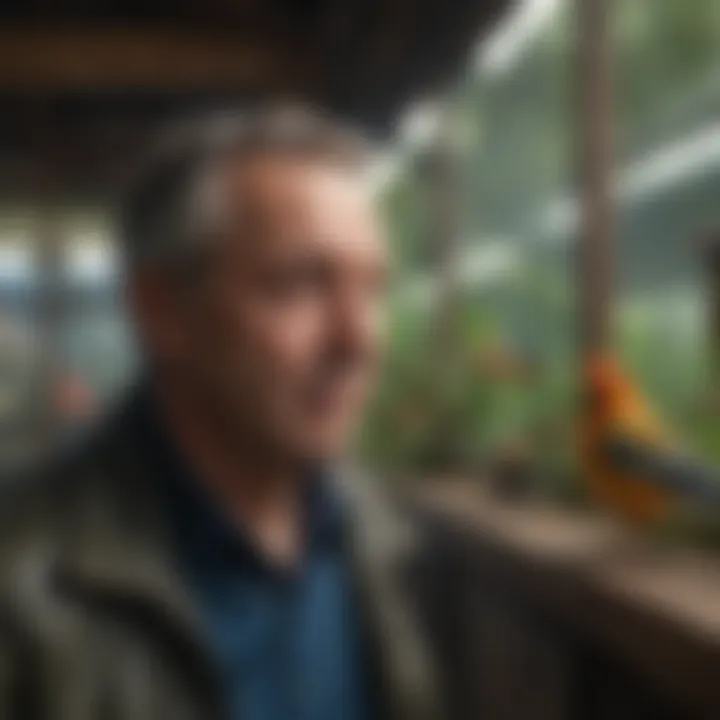
Owners must also be aware of signs of distress or illness in their birds. Regular veterinary care plays a key role in maintaining the health of birds. By embracing welfare standards, bird owners not only adhere to legal requirements but also create a thriving environment for their feathered companions.
Responsible bird ownership involves continuous education and commitment to ethical standards in avian care.
Benefits of Interaction and Bonding
Interaction between birds and their owners is vital for the well-being of avian pets. Walk-in bird aviaries create an environment that fosters these relationships. When birds have more space and freedom, their natural behaviors emerge, allowing for better engagement. Such settings provide opportunities for pet owners to witness and partake in their birds' social dynamics.
Understanding Bird Behavior
Birds are complex creatures with distinct personalities and behavioral traits. Understanding these traits is crucial for building a meaningful bond. Each species exhibits unique behaviors. For example, parrots are often social and tend to form strong attachments with their owners. Other species may exhibit more independence. Recognizing these differences aids handlers in adjusting their interaction style accordingly.
Behavioral cues, such as vocalizations, body posture, and preening, signal how birds feel in their environment. Birds that are active and vocal often seek attention or social interaction. Conversely, a bird that keeps its feathers flat or is silent may be stressed or feeling unwell. Learning to read these signs is essential for creating a comfortable atmosphere within the aviary.
Techniques for Engagement
Engaging birds effectively requires a combination of patience and creativity. Here are some techniques to enhance interaction:
- Consistent Routine: Establishing a daily interaction schedule can help birds feel secure. Birds thrive on predictability.
- Interactive Toys: Introducing toys that stimulate their natural instincts encourages playful behavior. Puzzle feeders, swings with bells, and mirrors can enhance interaction.
- Gentle Training: Using positive reinforcement techniques such as treats can help with training birds. This enhances bonding and allows for better compliance in behavior.
- Shared Space: Spending time inside the aviary with the birds promotes a sense of security. This provides opportunities for creative play and learning.
- Observational Learning: Watching each other can enhance trust. Birds learn from observing not only their own kind but also their human companions.
Building a bond takes time. A strong relationship with birds leads to improved mental health for both parties. It reduces stress for the animals and enhances their overall vitality.
"Birds are not just pets; they are companions who thrive on interaction and understanding. Investing time in their emotional needs benefits the entire environment."
Innovative Trends in Aviary Design
In recent years, there has been a noticeable shift in the design of walk-in bird aviaries. Innovative trends are arising that merge functionality with aesthetics. This transformation in aviary design not only enhances the experience for both birds and their owners but also aligns with contemporary needs and values, particularly in sustainability and technology.
These trends show a focus on creating spaces that are not only beautiful but also comfortable and stimulating for birds. Considering these aspects of design can significantly contribute to the overall well-being of the birds housed within these aviaries. Therefore, recognizing the importance of innovative trends is crucial for any avian enthusiast looking to construct or maintain a walk-in aviary.
Smart Aviaries: Technology Integration
Technology has made its mark on the design of aviaries, bringing new possibilities to bird care. Smart aviaries incorporate technological elements that promote enhanced habitat management and bird engagement. Sensors can monitor environmental conditions to ensure optimal air quality and temperature. Automated feeding systems can provide precise portions at scheduled intervals, reducing waste and ensuring nutritional needs are met.
Furthermore, apps and smart devices can help owners communicate with and monitor their birds from afar. For instance, a bird lover can use camera systems to observe their feathered friends remotely. This connectivity allows for a more interactive experience. Such advancements represents a critical evolution in how bird owners engage with their pets, ensuring that they are not only well-cared for but also remain enriched.
To illustrate:
- Remote Monitoring: Enables owners to check on birds via smartphone.
- Automated Habitat Features: Provides consistent care through automated systems.
- Data Collection: Gathers information for better understanding bird behavior.
Utilizing technology in aviary design maximizes the convenience for the owner while enhancing the life quality for the bird.
Eco-Friendly Materials and Techniques
Amid growing environmental awareness, the use of eco-friendly materials in aviary construction is gaining traction. Sustainable materials like recycled wood, non-toxic paints, and natural fibers reduce the ecological footprint of building projects. Utilizing these materials not only preserves the environment but also safeguards the health of the birds housed within.
Moreover, eco-friendly design often emphasizes natural habitats. Integrating features such as live plants, which can offer natural food, shelter, and stimulation, creates a more organic environment for birds. From bamboo to repurposed materials, avian enthusiasts are opting for options that balance aesthetics and sustainability.
Key considerations for eco-friendly aviary design include:
- Natural Ventilation: Reduces energy costs and keeps the habitat comfortable.
- Sustainable Sourcing: Choosing materials that are renewable and ethically sourced.
- Water Management: Implementing systems that conserve water while maintaining hygiene.
Through conscious material choices and design practices, aviary owners can create a sustainable space that supports both bird welfare and environmental health.
Keeping up with innovative trends not only enhances the functionality of aviaries but reflects the evolving attitudes of modern bird owners towards quality, sustainability, and technology.
Case Studies: Successful Walk-In Aviaries
Examining case studies of successful walk-in bird aviaries offers valuable insights into their construction, management, and the distinct advantages they provide. These case studies illustrate not only the aesthetic and functional aspects of aviaries but also highlight the ways in which they can foster community engagement and support the well-being of birds. By analyzing real-world examples, we can identify key considerations, best practices, and potential challenges that may arise.
Community Bird Sanctuaries
Community bird sanctuaries play a significant role in educating the public about bird care and conservation. These spaces are often designed to resemble natural habitats, providing a serene environment for birds while allowing visitors to engage with them safely.
- Educational Outreach: Many sanctuaries offer educational programs on avian care and conservation efforts. This helps both children and adults understand the importance of preserving bird species and their habitats.
- Conservation Efforts: These sanctuaries often participate in or promote local conservation initiatives. By raising awareness and funds for birds in the wild, they contribute to broader environmental efforts.
- Volunteer Opportunities: Community bird sanctuaries frequently rely on volunteers for daily operations. This fosters a sense of purpose and connection among community members.
Visiting a community bird sanctuary can be a life-changing experience for many. Witnessing the diversity of birds in a well-maintained aviary raises appreciation and understanding.
Private Aviaries of Enthusiasts
Private aviaries owned by bird enthusiasts showcase a different yet equally appealing aspect of walk-in aviaries. These spaces often reflect the personality and passions of their owners, demonstrating a deep commitment to bird welfare.
- Custom Designs: Owners often design their aviaries to meet the specific needs of their birds, incorporating unique features such as large flight areas, varied perches, and species-appropriate enrichment items.
- Interactivity: Many private aviaries are designed for close human-bird interactions. This is vital for socialization and bonding, allowing birds to flourish in an environment that promotes their natural behaviors.
- Ecological Considerations: Enthusiasts typically emphasize sustainable practices, using eco-friendly materials and maintaining a natural balance. This reflects a growing awareness among bird owners about the importance of environmentally-friendly practices.
Private aviaries not only enhance the lives of the birds housed within them, but also serve as an inspiration for others. They showcase how thoughtful design and mindful care can lead to vibrant and enriching environments for our feathered companions.
"Case studies remind us that both community and private efforts are crucial in promoting bird welfare and conservation."
Understanding these examples provides critical lessons for both aspiring and current aviary owners. Applying these principles can lead to the creation of successful aviaries that not only cater to the birds but also engage and educate the surrounding communities.
Finale
The conclusion of this exploration into walk-in bird aviaries emphasizes their indispensable role in the lives of avian enthusiasts and their feathered companions. Creating a space that caters both to the aesthetic and practical needs of birds fosters a harmonious environment that promotes well-being. This ultimate guide highlights the necessity of incorporating thoughtful design and attentive maintenance, ensuring that both the aviary and its inhabitants thrive.
Summary of Key Points
In this article, we have discussed various aspects surrounding walk-in bird aviaries, focusing on:
- Definition and Overview: Understanding what walk-in aviaries are and their growing popularity.
- Benefits: Enhanced spaces for birds, promoting physical health, mental well-being, and social interactions.
- Design Considerations: Importance of location, size, structure requirements, and materials used for safety.
- Interior Design: Need for natural elements, suitable perches, climbing structures, and enrichment toys.
- Maintenance: Routine cleaning, seasonal checks, and health monitoring requirements.
- Choosing Birds: Compatibility, size considerations, and understanding behavioral traits.
- Legal and Ethical Aspects: Regulations on ownership and welfare standards.
- Interaction and Bonding: Techniques for building a relationship with birds and understanding their behavior.
- Innovative Trends: Technology and eco-friendly materials in aviary design.
- Case Studies: Successful community and private aviaries illustrating the diverse applications of these spaces.
Future Directions in Aviary Development
As bird enthusiasts evolve in their practices, several future trends appear promising in the development of walk-in aviaries:
- Technology Integration: Smart aviaries incorporating technology to monitor bird health and safety.
- Sustainable Practices: Increased use of recyclable and eco-friendly materials will likely shape aviary construction.
- Enhanced Enrichment: The push for more interactive and stimulating environments, using advanced behavioral research will influence the design of aviaries to provide optimal engagement for birds.
- Community Involvement: Greater collaboration between enthusiasts and professionals for designing aviaries aimed at conservation and education, inspiring more bird lovers to engage in proactive stewardship.
By focusing on these key areas, the future of walk-in bird aviaries looks bright, providing even more opportunities for enriching the lives of both birds and their owners.















